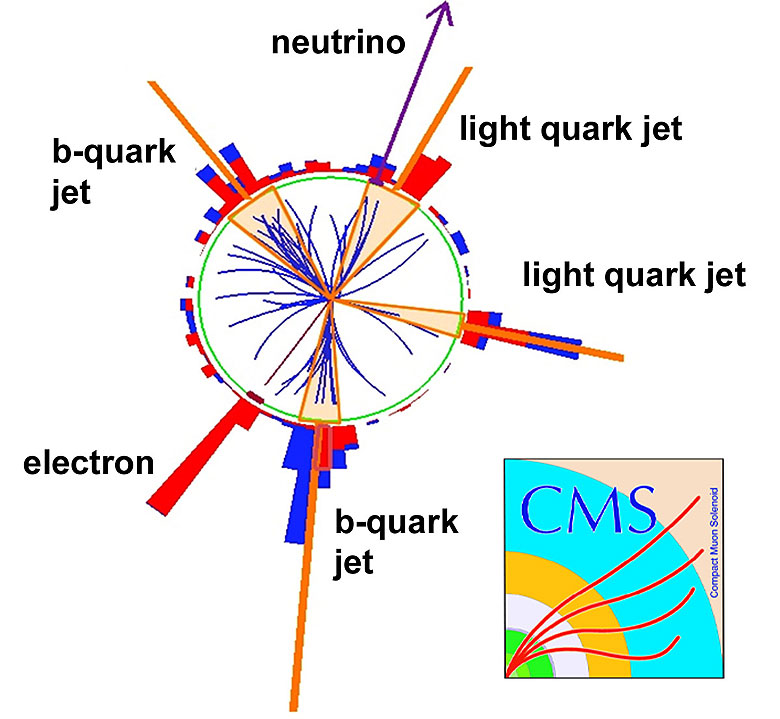
Physics Analyses
Standard Model Physics
The physics of the quarks and the W and Z bosons have been studied at past accelerators, but for some, notably the top quark and W boson, the precision of these studies have been limited by low production rates. The higher energies available at the LHC mean that they will be produced much more abundantly than before, offering an unprecedented opportunity to measure their properties. In addition, the production mechanism is different at the LHC, so that valuable new information will be accessible.
A candidate top quark anti-top quark event in CMS.
Top Quark Physics
The top quark is distinctive for its large mass and short lifetime. The short lifetime means that it decays before interacting with other quarks, as if it were a solo ("bare") quark. No other quark has that property. Moreover, because it is so heavy, it often has a special role in theories of nature at very high energies. If indeed this is the case, detailed study of the top quark might be our best hope for the discovery of this new physics. In any event, a detailed understanding of these "standard candles" is a requirement for any solid understanding of new physics. The Cornell group is studying top quarks in the final state with a lepton and jets, which balances purity against the advantages of a sizable event sample. Backgrounds are suppressed by identifying jets originating from a b quark ("b-tagging"), either by virtue of a displaced b decay vertex or by the presence of a soft muon from the b decay. We are also looking at two lepton final state in preparation for measuring dark matter particle masses (see below).- Top Physics at CMS pdf, talk given at Hadron Collider Physics Conference, Toronto, August 23 - 27, 2010.
- Selection of Top-Like Events in the Dilepton and Lepton-plus-Jets Channels in Early 7 TeV Data CMS-PAS-TOP-10-004 .
b tag via decay vertex - Julia Thom, Yao Weng (grad student), Hongwan Liu (Undergraduate), Bryan Scherrer (Undergraduate). Meeting time: Wednesdays at 8.30am. b tag via soft muon - Peter Wittich, Don Teo (grad student).
W Charge Asymmetry
The proton has an amazingly rich structure. Its constituent quarks, 2 up (u) and 1 down (d) quark, are accompanied by an ever-changing sea of quark-antiquark pairs and gluons (the carriers of the strong force that bind the proton's quarks together). These quarks, anti-quarks and gluons interact with each other and with the constituent quarks, constantly changing the fraction of the proton's momentum carried by each. Amazingly, the probability of finding a particular quark species or gluon with a given momentum fraction does NOT change, and can be measured. These probability distributions, or "parton distribution functions" (pdf's) (not to be confused with a certain file format), are crucial to LHC physics because they dictate the odds of producing a pair of top quarks or any other final state of interest. We are measuring the pdf's by comparing the production rates of W+ and W- bosons, which emerge from u + d -bar and d - u -bar collisions, respectively. The W+ rate has an advantage since the proton has twice as many constituent up as down quarks, but the exact asymmetry depends on the u and d quark and anti-quark pdf's, and hence offer a way to measure them. The Cornell group is focusing on W decays to electron + neutrino. Group: Lawrence Gibbons, Aleko Khukhunaishvili (grad student).Beyond the Standard Model
Supersymmetry
Supersymmetry, or something like it, could explain dark matter and solve other problems with the Standard Model. Its clearest sign would be collisions with a momentum imbalance due to undetectable particles. Our group is searching for such events with a variety of signatures that further distinguish them from conventional processes, including final states with high momentum jets, bottom quarks, or electrons, muons or taus. Groups and meeting times:Jets and b-tag - Julia Thom, Anders Ryd, Peter Wittich, Luke Winstrom (postdoc), Josh Thompson (postdoc), Ben Kreis (grad student), Don Teo (grad student), Gala Kaufman (grad student). Meeting time: Tuesdays at 11:30am US eastern time. Lepton (electron or muon) and Jets - Ritchie Patterson, Avishek Chatterjee (grad student). Meeting time: Thursdays at 11am US eastern time. Taus - Anders Ryd, Emmanuele Salvati (postdoc).
Search for the W'
The W and Z bosons are responsible for weak interactions, and they were discovered at CERN in the 1980s. Many theoretical models propose the existence of heavier versions of these bosons. We are performing a search for the more massive version of the W boson, known as the W prime. This would appear in our detector as events with a high-energy electron and a large amount of "missing" energy due to the escaping neutrino. In this case, new physics could be discovered if one detected a handful of these events all clustered around the same mass, which would peak far away from anything predicted by the Standard Model. This effort is conducted as part of an international team, with other members from German, Italian, and Korean universities. We are hoping that the W prime, if it exists, will also be discovered at CERN! Group: Peter Wittich, Darren Puigh (grad student).New Physics Model Discrimination
At the LHC, once signs of new physics have been observed, an interesting question will be which new physics model would explain the new phenomena. For example, a large excess in Missing Energy, hand in hand with jets, could be explained by new particles in the context of MSSM or Universal Extra Dimensons, as well as many others. We have studied strategies for distinguishing new physics scenarios using angular correlations between jets, which depend on the spin of the underlying new particles.- Model Discrimination at the LHC: A Case Study arXiv:0812.3135, Phys. Rev. D 79, 075024 (2009).
